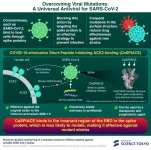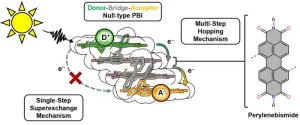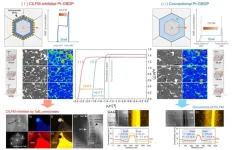(Press-News.org)
SARS-CoV-2, the virus responsible for COVID-19, infects cells by binding its spike protein to angiotensin-converting enzyme 2 (ACE2) receptors. Blocking this interaction with inhibitors could prevent infection. Since these inhibitors act directly on the virus without affecting human cells, they may be safer than some existing treatments. However, mutations in the spike protein can alter its structure, reducing the effectiveness of these inhibitors.
In a significant breakthrough, a research team led by Professor Yoshinori Fujiyoshi and Project Assistant Professor Shun Nakamura from the Cellular and Structural Physiology Laboratory, Advanced Research Initiative. Institute of Science Tokyo, in collaboration with the Department of Microbiology and Infection Control, Faculty of Medicine, Osaka Medical and Pharmaceutical University, has developed COVID-19 eliminative Short Peptide Inhibiting ACE2 binding (CeSPIACE), a mutation-tolerant spike protein inhibitor that remains effective against SARS-CoV-2 variants, including Omicron XBB.1.5. The study was published in the Proceedings of the National Academy of Sciences on January 24, 2025.
“All pathogen proteins, like the SARS-CoV-2 spike, have invariant structures critical for their functions, making them good targets for mutation-tolerant drugs, as seen in our peptide engineering,” says Dr. Fujiyoshi.
The team targeted the receptor-binding domain (RBD), a critical region of the spike protein responsible for binding to ACE2 receptors. Because this region is essential for viral function, it is less likely to mutate, making it an ideal target. Using cryo-electron microscopy and X-ray crystallography, the researchers analyzed the RBD structure to identify target sites. Starting with LCB1, a mutation-sensitive RBD-binding molecule, they developed a 39-amino acid peptide, enhancing its stability, mutation tolerance, and binding affinity to create CeSPIACE.
CeSPIACE is a short peptide made up of natural amino acids. It forms a two-helix bundle, which then self-assembles into a four-helix bundle with its RBD-binding site exposed, maximizing its ability to block the spike protein from binding to ACE2 receptors. While CeSPIACE primarily targets the ACE2-binding site, ensuring that mutations outside this region do not weaken its effectiveness, it was further engineered to recognize the stable backbone of the RBD, which remains unchanged even when side chains mutate. To ensure broad effectiveness across variants, the researchers adjusted its binding surface to accommodate specific mutations, such as Y501 in many strains after alpha one and N501 in the wild-type, making it effective against multiple SARS-CoV-2 variants.
CeSPIACE demonstrated strong binding to the RBDs of major SARS-CoV-2 variants, with a picomolar (pM) affinity ranging from 44 pM to 928 pM. In vivo tests with Syrian hamsters showed that a three-day intranasal treatment against the Delta variant led to a 1,000-fold drop in the amount of virus compared to untreated controls. In vitro experiments with human lung-derived Calu-3 cells showed clear efficacy against multiple variants (WT, Alpha, Delta, and Omicron BA.5) , blocking viral entry into pre-treated cells and preventing reinfection of cells already exposed to the virus.
These findings suggest that CeSPIACE can be used both as a prophylactic (preventive measure) to block infection and as a therapeutic in treating infection after exposure to the virus. Unlike biological antibodies, which are complex and costly to produce, peptides like CeSPIACE are simpler, cheaper, and easier to manufacture, allowing for rapid large-scale production during outbreaks. Additionally, peptides are chemically stable and do not require cold storage, making them easier to distribute globally.
Such an approach could also be used to develop potential treatments for other viruses, such as influenza or human immunodeficiency virus. “Unknown infectious diseases will continue to emerge. Our strategy of engineering mutation-tolerant inhibitors can be applied to developing therapeutics against other existing infections or future pandemics,” says Dr. Fujiyoshi.
-----------------------
About Institute of Science Tokyo (Science Tokyo)
Institute of Science Tokyo (Science Tokyo) was established on October 1, 2024, following the merger between Tokyo Medical and Dental University (TMDU) and Tokyo Institute of Technology (Tokyo Tech), with the mission of “Advancing science and human well-being to create value for and with society.”
END
Magnetic materials have become indispensable to various technologies that support our modern society, such as data storage devices, electric motors, and magnetic sensors. High-magnetization ferromagnets are especially important for the development of next-generation spintronics, sensors, and high-density data storage technologies. Among these materials, the iron-cobalt (Fe-Co) alloy is widely used due to its strong magnetic properties. However, there is a limit to how much their performance can be improved, necessitating a new approach.
Some of the earlier studies have shown that epitaxially grown films made up of Fe-Co alloys doped with heavier elements exhibit remarkably high ...
(Boston)—Digital voice recordings contain valuable information that can indicate an individual’s cognitive health, offering a non-invasive and efficient method for assessment. Research has demonstrated that digital voice measures can detect early signs of cognitive decline by analyzing features such as speech rate, articulation, pitch variation and pauses, which may signal cognitive impairment when deviating from normative patterns.
However, voice data introduces privacy challenges due to the personally identifiable information embedded in recordings, ...
Researchers at the University of Birmingham have developed a new method for the rapid scalable preparation of uniform nanostructures directly from block polymers.
This novel approach, led by the Dove and O'Reilly groups, significantly reduces processing time from a week to just minutes, enabling high-throughput production of precision polymer nanomaterials.
Publishing their findings today (14 Mar) in Nature Chemistry, the teams outline a rapid seed preparation technique that supersaturates polymer solutions in a flow system.
The process facilitates uniform seed micelle formation and allows ...
Photosynthesis is a marvellous process: plants use it to produce sugar molecules and oxygen from the simple starting materials carbon dioxide and water. They draw the energy they need for this complex process from sunlight.
If humans could imitate photosynthesis, it would have many advantages. The free energy from the sun could be used to remove carbon dioxide from the atmosphere and use it to build carbohydrates and other useful substances. It would also be possible to produce hydrogen, as photosynthesis splits water into its components oxygen and hydrogen.
Photosynthesis: a Complex Process ...
People with favourable socioeconomic conditions, such as high incomes or education levels, face a reduced risk of age-related diseases and show fewer signs of biological ageing than peers of the same age, finds a new study led by University College London (UCL) researchers.
Social inequalities appear to have a direct impact on the biological ageing process, according to the authors of the Nature Medicine paper.
The scientists found that people with more social advantages had fewer proteins in their blood that are linked to the ...
The Nano Materials Research Division at the Korea Institute of Materials Science (KIMS), led by Dr. Tae-Hoon Kim and Dr. Jung-Goo Lee, has successfully developed a groundbreaking grain boundary diffusion process that enables the fabrication of high-performance permanent magnets without the use of expensive heavy rare earth elements. This pioneering technology, marks the world’s first achievement in this field.
Permanent magnets are key components in various high-value-added products, including electric vehicle (EV) motors and robots. However, conventional permanent magnet manufacturing processes have been heavily dependent on ...
23% of people infected with SARS-CoV-2 between 2021 and 2023 developed long-COVID, and in more than half of them the symptoms persisted for two years. These are the main conclusions of a study conducted by ISGlobal, a centre supported by the ”la Caixa” Foundation, and in collaboration with the Germans Trias i Pujol Research Institute (IGTP), as part of the European END-VOC project. The risk of developing long-COVID depends on several factors, according to the results published in BMC Medicine.
After overcoming an initial ...
Violence is trapping women across Northern Ireland in cycles of trauma and homelessness, with some facing further abuse in temporary accommodation, despite moving there to find a place of safety.
The research from Heriot-Watt University and University of Edinburgh was commissioned by the Community Foundation for Northern Ireland and funded by the Oak Foundation. It is based on in-depth interviews with women with lived experience of violence over five areas of Northern Ireland.
The areas include Belfast and Derry, one smaller urban area in County Down, and two more rural areas of County Antrim and County Fermanagh. The report also covers findings from focus groups with frontline workers ...
Researchers from Brazilian, Argentine, and Uruguayan institutions analyze the barriers that low- and middle-income countries face in disseminating research on intensive care medicine, particularly in the treatment of critically ill patients. Published this month in The Lancet, the study highlights how historical and economic biases perpetuate inequalities and suggests changes to make the scientific publishing system more inclusive and representative of the global community.
Low- and middle-income countries are home to 85% of the world's population and bear a disproportionate burden of critical illnesses. ...
PHILADELPHIA— Prior exposures to specific types of seasonal influenza viruses promote cross-reactive immunity against the H5N1 avian influenza virus, according to new research from the Perelman School of Medicine at the University of Pennsylvania. Older adults who were exposed to seasonal flu viruses that circulated prior to 1968 were found to be more likely to have antibodies that bind to the H5N1 avian flu virus. The findings, published today in Nature Medicine¸ suggest that younger adults and children would benefit more from H5N1 vaccines, even those not tailored specifically to the current strain circulating in birds and ...






